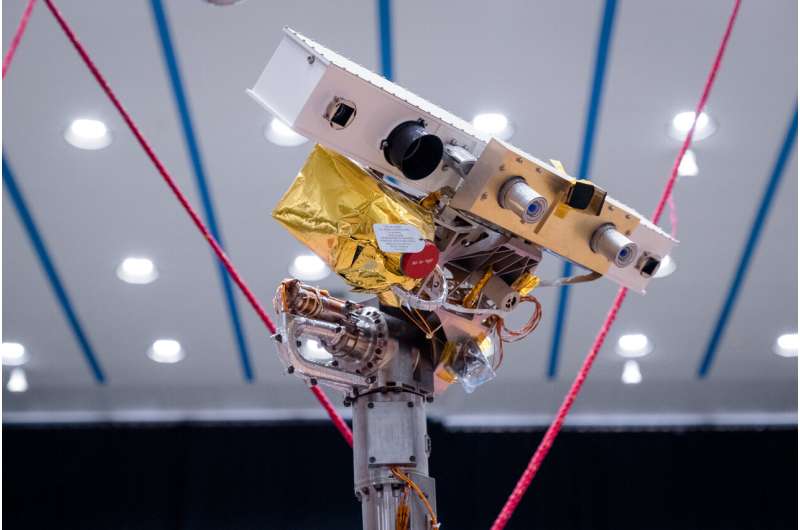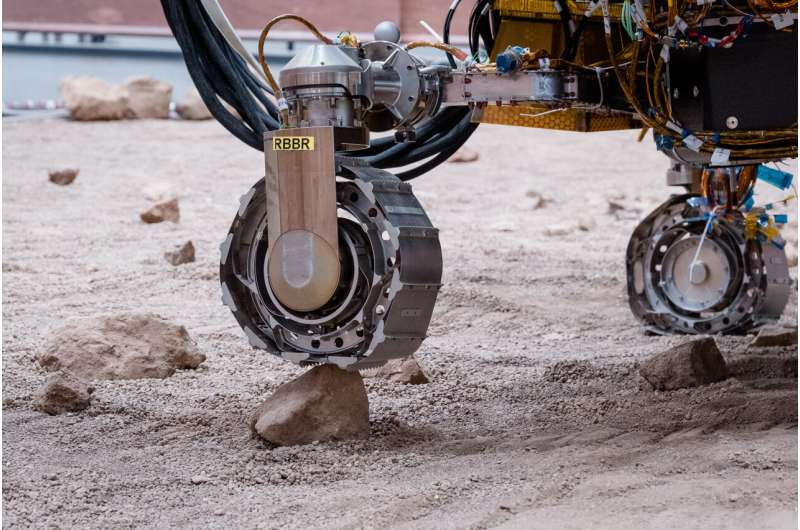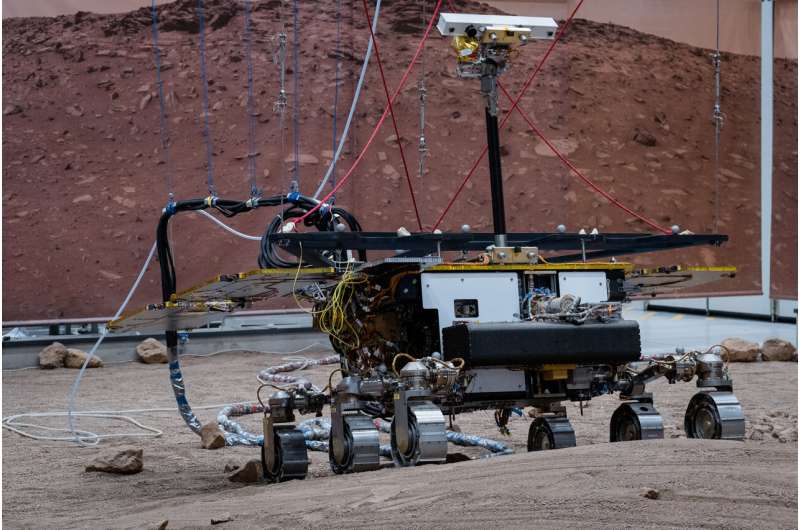Science in motion for ExoMars twin rover

The first science tests for the ExoMars rover replica kicked off after several weeks of driving tests around the Mars Terrain Simulator at the ALTEC premises in Turin, Italy.
With the locomotion system up and running, it is time now for the rover's cameras and instruments to scan a Mars-like terrain—both on and under the surface—in search for the best samples.
The twin of ESA's Rosalind Franklin rover, also known as The Ground Test Model (GTM), has been busy surveying 64 square meters of terrain in one of Europe's largest Mars yards, carefully staged with sandy areas and rocks of various sizes, as well as gravity and light simulations to recreate the environment on Mars.
See, snap, survey
Imaging comes first. Two stereo cameras at the top and at the bottom of the rover's mast—NavCam and LocCam—allow the GTM to 'see' in three dimensions and identify the rocks and slopes ahead. The cameras guide the rover through safe paths and help avoid hazards.
Once the rover is on the move, two more sets of cameras—PanCam and CLUPI—come into play to get a whole picture of the site with high resolution imaging. These rover 'eyes' send panoramic and close-up images of the terrain to the operators at the Rover Operations Control Centre (ROCC). Teams from Thales Alenia Space and ALTEC worked in synergy with ESA engineers.
The images are essential to map the geological context and to help the scientists decide where the rover should stop and survey the surface in more detail.
Choosing the target
Finding suitable samples involves a lot more than just spotting an outcrop and digging. The rover is equipped with a ground penetrating radar—WISDOM—and a neutron detector—ADRON– to understand what lies beneath the surface.
The search for evidence of life on Mars is a main objective of the ExoMars 2022 mission.
If anywhere on Mars, traces of past or present life are most likely to be found underground, where ancient biological signatures may still be preserved from the harsh radiation on the Red Planet.
Much as archaeologists on Earth excavate sites, WISDOM can work by analyzing the area in a grid fashion—by breaking the ground into small squares. The neutron spectrometer in ADRON will work in tandem with the radar to detect water and hydrated minerals below the surface.

Test cases for Mars
Operators are rehearsing all possible mission scenarios to prepare for Rosalind Franklin's arrival in Oxia Planum on Mars in June 2023.
The first tests with science in action started with the rover doing a traverse to characterize a sandy and flat area. After roving for a while, the cameras fed the operators with stereo and high-resolution images.
Once a location deemed intriguing enough to drill for samples is found, it was time to get more information from beneath the surface.
The ground penetrating radar WISDOM ran its science analysis every 10 cm for 30 seconds. Once the wheeled lab covered five meters, it performed two turns of 90 degrees and started all over again on a new five-meter track. At the end of the test, WISDOM scanned a grid of 25 square meters.
A second test repeated this sequence, this time around with a much longer drive of eight meters for a more far-reaching science acquisition. And instead of stopping every half a meter, the GTM used WISDOM every meter.
In both cases, the sequence was completed by the neutron detector, Adron, which took measurements looking for traces of water. Next up was the execution of a complete WISDOM grid of 25 square meters.

Where to drill?
These dry runs simulate the sequences the rover will follow on Mars, where the scientists will need to decide which area is worth drilling. Rosalind Franklin is fitted with a drill to extract samples down to a maximum of two meters, deeper than any other rover and a first in Mars exploration.
As a bonus during this first science dry run, the rover attempted some drilling at various depths and through a layer of sample material selected by the ExoMars team.
On Mars, the sample collected by the drill will be crushed into a fine powder and delivered to the analytical laboratory at the heart of the rover to analyze its mineralogy and chemistry.
With no summer break for the rover, upcoming tests at the Mars Terrain Simulator will involve the analysis of samples inside the rover's analytical lab. A suite of instruments—MicrOmega, Raman and MOMA—will study the mineralogical and molecular composition of the soil.
During the real mission to the Red Planet, the results of this analysis could answer questions about the potential origin, evolution and distribution of life on Mars
Provided by European Space Agency

















